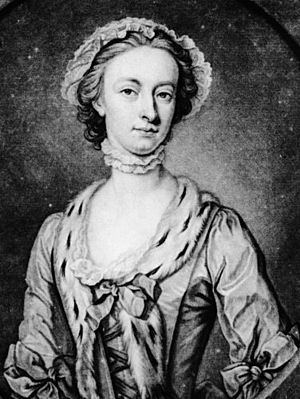Mary Blandy facts for kids
Quick facts for kids
Mary Blandy
|
|
|---|---|

Blandy in 1751/52
|
|
| Born |
Mary Blandy
1720 |
| Criminal penalty | Hanged 6 April, 1752 (aged 31-32) |
| Details | |
| Location(s) | Henley, United Kingdom |
| Target(s) | Francis Blandy - father |
| Killed | 1 |
| Weapons | Poisoning by arsenic |
Mary Blandy (1720 – 6 April 1752) was an English woman from the 1700s. She became known for a very sad event. In 1751, she gave her father, Francis Blandy, something that made him sick. She said she thought it was a special "love potion." She believed this potion would make her father approve of her boyfriend, William Henry Cranstoun. However, the "potion" was actually a dangerous poison called arsenic.
Mary's Life and a Tricky Romance
Mary grew up in Henley-on-Thames, England, where she lived her whole life. People in her town thought she was a smart, polite, and well-educated young woman.
In 1746, Mary met Captain William Henry Cranstoun. He was an army officer and the son of a Scottish nobleman. Mary and William planned to get married in 1751. But then, a big problem came out: William was already married to another woman in Scotland and had a child with her! William said his first marriage wasn't real. He traveled to Scotland many times to try and end it.
Mary's father, Francis Blandy, became very suspicious. After many months, he believed William didn't really plan to leave his wife. Mr. Blandy made it very clear he did not approve of William.
What happened next is a bit unclear. Mary later said that William sent her a "love potion." He told her to put it in her father's food. Mary claimed she thought this potion would make her father like William more. She did put it in his food, and sadly, her father died.
The Trial and Public Debate
Mary Blandy's trial happened on 3 March 1752. It was quite interesting for its time because of the science involved. A doctor named Anthony Addington gave expert testimony about the arsenic poisoning. He had done some basic tests on the leftover poison. These tests were very new and exciting in the 1700s. Dr. Addington's work in this case helped his career a lot.
On 6 April 1752, Mary Blandy was hanged outside Oxford Castle prison. Her case got a lot of attention from newspapers and the public. Many small books were published, claiming to tell her true story or show her real letters. People had different opinions about her. Some believed her story that she thought it was a love potion. But most people thought she was lying.
The discussion about whether she was truly responsible for her crime continued for many years after her death. Later, in the 1800s, some people looked at her case again. They started to feel more sympathy for her, seeing her as a "poor lovesick girl" who might have been tricked.

